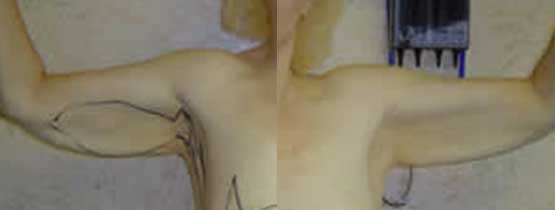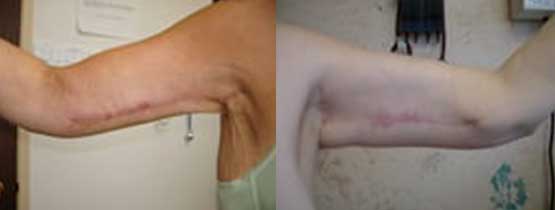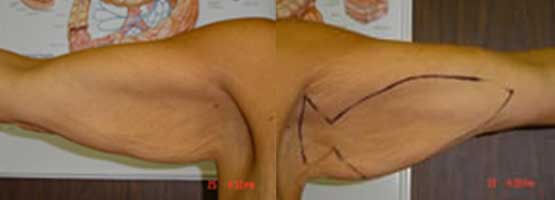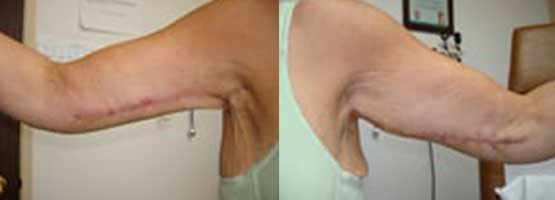A more complete pdf version of this information can be found by clicking Brachioplasty Information Sheet.
Arm Lift (Brachioplasty) is a surgical procedure that removes excess skin from the upper arm. There are different degrees of ptosis (drooping) deformity. Brachioplasty arm reduction surgery can remove the excess tissue and reduce the circumference of the upper arm. Surgical correction depends on the amount of extra skin and how loose the supporting tissues have become. Extra skin is removed from incisions along the inner arm. The incision must be placed where the tissue can be best tightened.
The most common incision extends from the elbow to the axilla. This permits the excision to maximally address the redundant skin in the middle. Modification of the incision may be necessary to limit scar contracture in the axilla. You may have a drain placed in each arm. Because of the level of the incisions, visible scars can be a major concern. It becomes a choice between the loose wobbling extra skin and the scar from the excision. After surgery scar care can limit the degree of scarring. Clothing style can help camouflage some of the scar, but not the loose skin before surgery. Other possible compilations include persistent swelling of the arm, infection, bruising, and bleeding. Nerve injury can result in numbness and change in feeling.
This surgery is not suitable after mastectomy or operations in the axilla lymph nodes. Those with multiple infections of the sweat gland may also not be candidates for brachioplasty. Drainage of the arm may already be impaired, and further surgery may lead to permanent arm swelling.
Each patient needs to be examined and their goals must be made clear before a realistic expectation regarding this type of surgery can be made.
Planning your surgery :
You should come to the office prepared for an extensive consultation. Dr. Keshishian will need to learn about your medical history, problems, surgeries and current medications. Prior cosmetic and other surgeries are important to tell your surgeon about. You will need to help Dr. Keshishian understand what bothers you regarding this area. Redundant skin and adherent scars are a dynamic problem and Dr. Keshishian will need to see how the skin drapes, where the extra tissue is located, and examine your scars. Dr. Keshishian will then discuss what surgery has to offer and the are different surgeries possible depending on the anatomical defect and the nature of your tissues. Dr. Keshishian will then recommend what method of surgical sculpting is best suited for your problem and then discuss the risks, benefits and alternate methods of care. Understanding the benefits and limitations of surgery helps with realistic expectations.
The office examination permits an appropriate examination of the problem. At the time of your evaluation copies of:
- prior operative reports
- doctor’s office notes
- laboratory results
- actual x-ray films (not just the reports)
- photographs before surgery
when available can help us better understand your needs. Your surgeon may ask for additional tests prior to surgery.
How to prepare for Brachioplasty:
Your doctor will give you specific instructions to prepare for surgery but here are some general guidelines:
- Avoid aspirin, any aspirin containing medication or any other non-steroidal anti-inflammatories (NSAID), such as Motrin® or Advil®, and homeopathic remedies for 10 days prior to treatment. Because aspirin thins the blood, it can interfere with normal blood clotting and increase the risk of bleeding and bruising.
- Smoking inhibits the healing process, so stop smoking at least 6 weeks before your procedure and if you start again, make sure it is after you are completely healed.
- Avoid drinking alcohol a few days before your surgery.
- Make sure to follow any fasting instructions the night before and morning of your surgery. Your doctor may insist on an empty stomach depending on the type of anesthesia.
- Make sure that you arrange for someone to bring you home and to help you out for at least 24 hours after surgery.
Be sure to raise any questions or concerns that you may have about the procedure, outcomes, or safety of the procedure during your consultation.
Recovery:
Recovery takes one to two weeks, depending on what was done. Return to work depend on the activity needed on the job but is often about 2 weeks. The dressing may be extensive with elastic support or something smaller. You will need to protect the incisions after surgery. Limiting lifting is important. Elevation with pillows increases comfort. It can take 6 months or more to see how the scars will evolve. Although everyone heals at a different rate, you can expect that your recovery will follow this general time line: The procedure may be done on a outpatient basis or you may spend a night in the hospital. Call the office immediately with any unusual symptoms or concerns.




